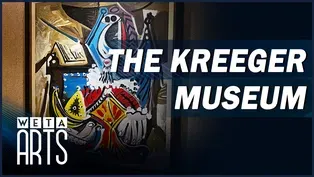
Experience the Ocean's Twilight Zone at ARTECHOUSE
Clip: Season 12 Episode 3 | 9m 25sVideo has Closed Captions
A groundbreaking digital exhibition brings deep ocean life to Washington, D.C.
Dive beneath the waves and explore the mysteries of the ocean’s twilight zone right in Washington, DC! Join host Felicia Curry as she takes you into ARTECHOUSE’s groundbreaking digital exhibition, where cutting-edge technology brings the wonders of the deep ocean to life.
Problems with Closed Captions? Closed Captioning Feedback
Problems with Closed Captions? Closed Captioning Feedback
WETA Arts is a local public television program presented by WETA

Experience the Ocean's Twilight Zone at ARTECHOUSE
Clip: Season 12 Episode 3 | 9m 25sVideo has Closed Captions
Dive beneath the waves and explore the mysteries of the ocean’s twilight zone right in Washington, DC! Join host Felicia Curry as she takes you into ARTECHOUSE’s groundbreaking digital exhibition, where cutting-edge technology brings the wonders of the deep ocean to life.
Problems with Closed Captions? Closed Captioning Feedback
How to Watch WETA Arts
WETA Arts is available to stream on pbs.org and the free PBS App, available on iPhone, Apple TV, Android TV, Android smartphones, Amazon Fire TV, Amazon Fire Tablet, Roku, Samsung Smart TV, and Vizio.
Providing Support for PBS.org
Learn Moreabout PBS online sponsorship♪ Felicia Curry: Near the Capitol in Southwest DC, an underground lair has been transformed into a digital underwater experience.
♪ Woman: Being immersed in this underwater wonderland, it was just amazing.
And then it had science that backed it up.
♪ Woman: The digital art aspect of it was so incredible.
I thoroughly enjoyed myself.
♪ Woman: I would never go to the deep ocean personally, so it's nice to be able to see from the comfort of Washington, DC.
Curry: The exhibition is called "Twilight Zone: Hidden Wonders of the Ocean."
Woman: The twilight zone is really amazing and incredibly important to our planet.
♪ It's the layer of the ocean that extends hundreds of meters from the surface.
It's way too dark in the twilight zone for you and I to be able to see anything, but there are specialized creatures that live down there that can tell whether it's night or day, even though there's very tiny amounts of sunlight.
And the more we look, the more we find how incredibly dynamic it is.
We started thinking how amazing it would be to have some kind of immersive experience, so people who will never get to go to the "Twilight Zone" could see, get a sense of what it's like... Oh, did you see the siphonophores go by?
share the science.
So we talked to ARTECHOUSE, and we looked into their mission, and it looked like a perfect match, and here we are.
Curry: ARTECHOUSE is the brainchild of Sandro Kereselidze.
Sandro Kereselidze: The idea of ARTECHOUSE is to have a place where you can experience dynamic, innovative art for audience of 21st century.
♪ Using the latest tools and technology, we develop stories, and I think science has so much to tell.
I'm coming from a family of movie directors... Curry: Kereselidze founded ARTECHOUSE in 2015.
Kereselidze: At ARTECHOUSE, we try to push the boundaries of next generation of scientists, next generation of artists.
Kereselidze, voice-over: Before ARTECHOUSE, me and my wife were doing over 200 events around this area, and I was connected to a lot of artists who use technology.
Before that, there was no place dedicated to this type of storytelling.
Somebody had to fill out the void, and that's how ARTECHOUSE came to life.
This is actually our third major show telling the science stories.
♪ We did a partnership with NASA to tell the story of the universe and what's above us.
We also done amazing partnership with the Society for Neuroscience, telling what's happening in our brain.
♪ And now we're going all the way deep to the ocean.
♪ And it's like there's a whole universe.
We can tell that story together of all this research in a new way for a new audience of today.
That's kind of cool.
How are things going, though, overall?
It's going to be cool.
Curry: Alongside Kereselidze, Riki Kim led the dialog with the scientists.
Riki Kim: One thing that keeps coming up in their scientific literature is about the biodiversity of the twilight zone and the massive migration that happens daily.
We took that as a cue.
If animals are migrating every day, let's make our story 24 minutes.
That covers 24 hours.
Some of the creatures, like siphonophores, and weird creatures like the Strawberry Squid, the bioluminescence, which everybody loves to talk about, those things are featured in the Immersion Gallery and explores them further.
Man: When this opens up, see, you have... Curry: The rooms off the Immersion Gallery are dedicated to interactive exhibits.
Man: The auxiliary galleries are intended to kind of add to topics that the Immersion Gallery space doesn't fully cover, and we make those interactive to add some depth to the content in the main gallery.
There's a whole range of ways to get input from people in the space, and then do something with that and give them a response.
Sometimes it involves cameras to track people's movement in a space and then influencing projected content.
We also sometimes use physical hardware, like buttons and joysticks.
One of those spaces focuses on the Mesobot, an autonomous robot scientists use to research where they can't go and see themselves.
This is the Mesobot here.
So you have, like, a lever that you can use to move between different depths.
♪ And you can hit a button to show you sort of the Mesobot's perspective and get information about the different creatures that it does encounter.
♪ Curry: Another interactive exhibit interprets bioluminescent creatures.
Simon Alexander-Adams: The Atolla jellyfish has this blue bioluminescence that happens when it's startled.
There's some fun sound design.
More imaginative since I don't think they actually make sounds.
[Chuckles] But this is a way to, like, imagine the sort of weird creatures.
Heidi M. Sosik: We've been able to talk to them.
They've respected our concerns and sometimes tweaked the way that the exhibit was going to appear.
It's been really fun to have that give and take.
Kereselidze: I had this idea to, like, have air bubbles activating the jellyfishes, and gives you all the information, and we can appreciate it.
That's the whole goal of this exhibit-- to spark curiosity and interest.
Beautiful jellyfish.
[Chuckles] Kim: The reality is that what we're doing happens in digital content, so we still need to be onsite for this thing because we have to see it.
How are things going?
Going well.
Tuning up the mapping here on the floor and then it's on to that side.
Looking good.
Looking good.
Can't wait, can't wait, man.
We are a few hours away from opening, and there's always some surprises with the technology.
But our team troubleshoots, and bringing this exhibition to life.
Let's make it happen.
♪ Curry: With miles of cable, dozens of projectors, and crates of sensors, ARTECHOUSE brings the ocean depth to the surface.
Sosik: And this project and this exhibit are just like the culmination of so much learning and knowledge, and I really appreciated learning to think differently about the ocean twilight zone and about the value of the ways that the artists were thinking about how to share the knowledge.
♪ Curry: There's no more time for testing.
The first guests have arrived.
[Indistinct chatter] Guide: Feel free to head downstairs for a brief introduction... Narrator: Dive into the enchanting waters of "Twilight Zone: Hidden Wonders of the Ocean."
Discover the daily awe-inspiring animal migration from deep within the ocean to the surface.
♪ [Sound of waves breaking] Woman: It was funny.
At first, they're all standing very politely, taking a look, and then people started to get more relaxed and really sit on the floor and lean back, take it in.
I think people were really immersed in the exhibit and really kind of feeling the waves of life, even if they weren't quite sure what they were looking at, knowing that it was important and it was exciting.
Man: Those scientists and the whole idea of exposing people to all those mysteries and things we see under a microscope, these things we don't see, to make that accessible to people with art, I think that's so awesome.
Sosik: It's really been fun over the course of the project to see how Mesobot has almost become a character in the story about our science, and having it show up in this exhibit in such an interactive and fun way is really part of that arc that I really love.
And with everything coming to life tonight and the amount of enjoyment I see other people having is also really kind of overwhelming.
♪ It makes me feel very emotional.
Kereselidze: I hope you guys like this show because we really worked very hard.
Kereselidze, voice-over: The future of ARTECHOUSE is to be in every city, and I think we can push those limits even more.
This is just the beginning.
Curry: You can see "Twilight Zone: Hidden Wonders of the Ocean" through November 17th.
And starting November 22nd, catch their annual holiday special.
Go to artechouse.com for details.
Go Behind the Scenes with the US Air Force Honor Guard Drill Team
Video has Closed Captions
Go behind the scenes with the U.S. Air Force Honor Guard Drill Team. (9m 51s)
The Kreeger Museum Offers a Unique Art Experience in Washington DC
Video has Closed Captions
Discover why the Kreeger Museum offers a unique art experience in Washington, D.C. (7m 7s)
Preview: WETA Arts November 2024
The Air Force Honor Guard Drill Team, ARTECHOUSE, and the Kreeger Museum (30s)
Providing Support for PBS.org
Learn Moreabout PBS online sponsorshipSupport for PBS provided by:
WETA Arts is a local public television program presented by WETA














